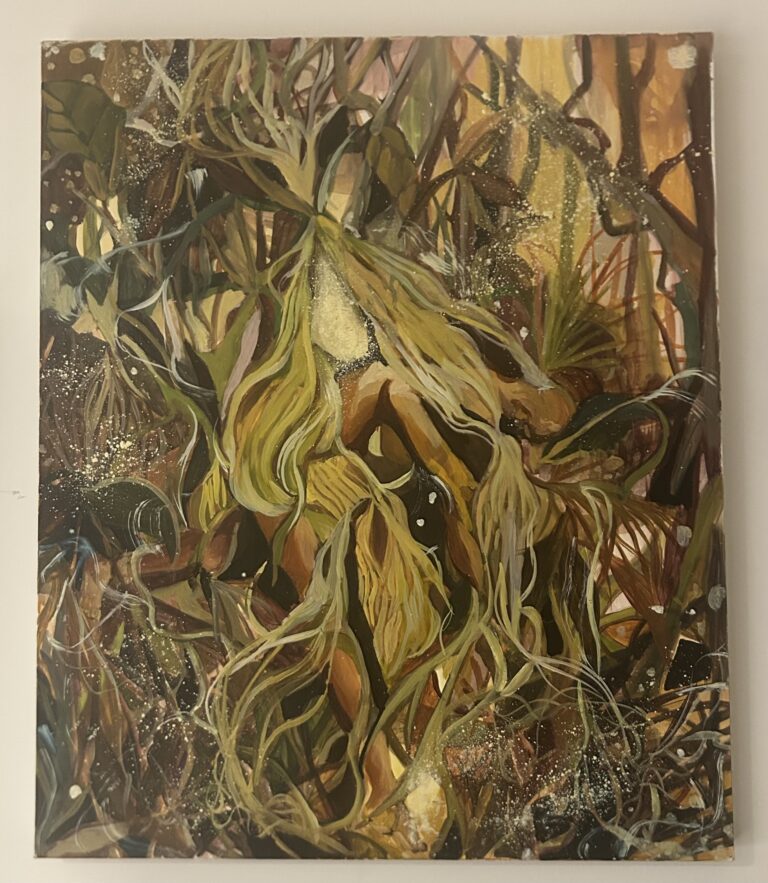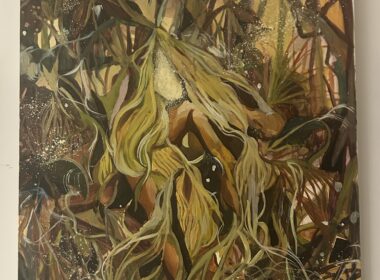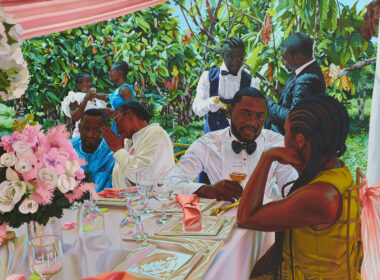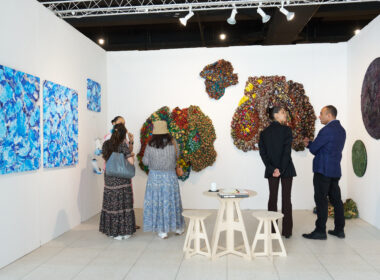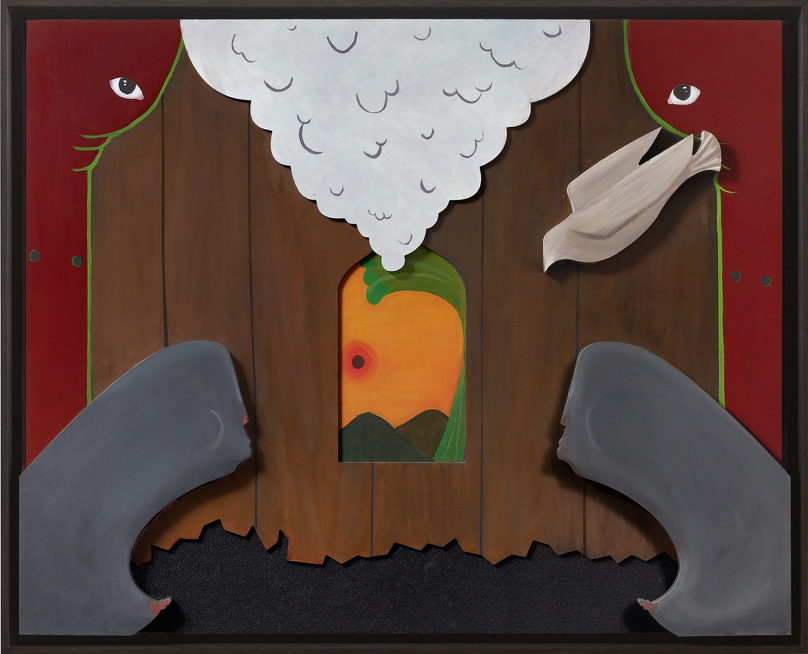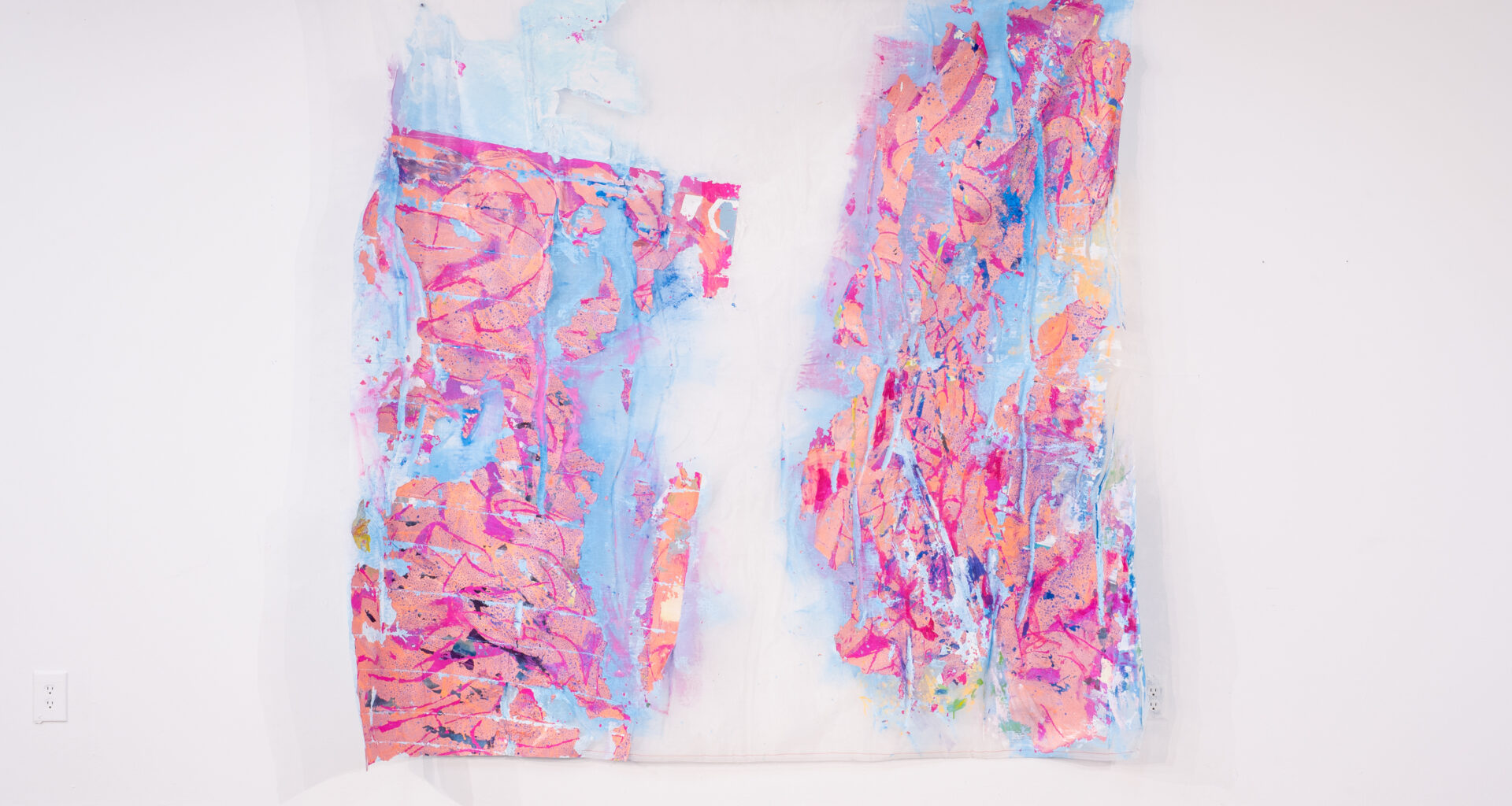Above: Alexandria Smith, [Ruminations on] the joy fantastic, 2022
mixed media on three-dimensional wood assemblage. 50 7/8 x 62 15/16 x 1 3/4 inches 129.3 x 159.8 x 4.5 cm © Alexandria Smith Photo: Prudence Cuming Associates LtdCourtesy the Artist and Gagosian
Do you remember your dreams? What worlds do you traverse? What messages do you receive? In Pretend Gravitas and Dream Aborted Givens, the first solo exhibition by Alexandria Smith, organized by Antwaun Sargent for Gagosian New York (April 28-June 4, 2022), Smith references Black feminist figuration, traditional spiritual cosmogonies, and Black womanist literary imaginations to render a vibrant selection of refreshingly surreal, mixed-media works. A self-described “closeted writer,” Smith’s prolific sensibility to tap into the visions that typically are revealed only in REM sleep stages, allows us to dream while awake and review images that glean past, present and future prospects for Black femme-identifying lives.
“I feel like writers have always understood my mind, my thought process, my imagination, and it’s been rare for me to find artists, visual artists that do the same,” Smith shared with this writer. “I think they’re a handful now, but I mean, growing up, there were very few that I was exposed to, so I always turned to books and my parents sort of fostered that.”
Looking upon the worlds that she renders is like traveling to another dimension. Oceans arc above a trinity of one-eyed light-bearers. The land is both water and flesh: arms, rounded breasts and erect nipples of headless blue-black women stand steadfast, unmoved, and powerful in their ascendant forms. The more you explore the exhibition, the better you are able to read the series as an epic, nonlinear mythopoetic tale. Transformative totems, revelatory icons and lyrical titles guide us through an enlightening journey into the subconscious ruminations of a brilliant mind.
The images that Smith conjures are informed by an incredible heritage of Black women scholars and queer visionaries who grounded their work in spiritual reverence and aligned their pedagogy with legacies of intuitive praxis.
“I feel like only another Black woman in particular could get this, or a POC person can get this idea of spirituality,” Smith continued. “So [I] listen to the material, [I] listen to the work, and the only way I can do that is if I remove the analytical or logical. When I’m making and allow that part to come in later, I just serve as a conduit, and when I start to think too much about it, when I start to be influenced in a way, it sort of interferes. [There] is a lot of daydreaming that I allow to happen, like waking day dreaming.”
Materiality becomes an essential component in the way viewers read and experience the work. Each mixed-media assemblage on three-dimensional wood or paper in the Pretend Gravitas and Dream Aborted Givens series exquisitely conceives dimension in expansive ways: as a literal three-dimensional mixed media construction; as literary references to interdimensional travel as iterated by Black womanist speculative fiction; and as a historical assessment of subjugating figurative tropes that diminished the multidimensionality of African diaspora women by depicting them as subhuman, servile subjects in visual art.
Engaging dimension as a pedagogical and praxis-informed conceptual tool serves as a bridge by which viewers can orient their expectations of dreamtime, spacetime and mythology, respectively, through an intentionally affirmative Black lens. In these meta-conscious states, our perceptions of time, depth and space shift so that we can experience the expansiveness and physics-defying parameters of the dreamworlds we inhabit. Smith uses mixed media to enunciate the enhanced cognition that we experience when we dream.
“It took a long time to get here … I’ve been a teacher for over a decade and [even] before grad school, and I [was collaging],” she said. “And all I had was the photocopy machine, so I started printing out images of my paintings that I had been making and then felt compelled to collage them. I was sourcing and remixing my own work and [to] create these collages, and those were sort of fun and playful and intuitive and [a] similar energy to drawing, which is always the backbone of my practice. That evolved into making large-scale collages, which I called collage installations, that were sort of dependent on the wall. They weren’t contained within a rectangle square or on a surface; they were just free.”
Smith’s continuous experimentation with material allowed her to find solace in the practice and process of assemblage. By remixing old paintings and collaging them into new constructions mounted onto wood, Smith was given a new expressive freedom; she could apply her painterly figurative approach to invigorate three-dimensional sculptural forms. Utilizing CNC (Computer Numeric Controlled machine) and Jigsaw cutting techniques as primary tools, Smith created assemblage works that encompass natural forms and accentuate the round curvature of Black women’s silhouettes. Though she doesn’t consider herself to be a traditional sculptor, the techniques that she engages cultivate an imaginative strategy to work with mixed media in more culturally astute and aesthetically dynamic ways.
“I’m not a sculptor, I don’t have the skills of a sculptor. I can dabble in it and have things fabricated, but I’m also very interested in having some sort of involvement at every stage, or at the bulk of the making process … What I felt I was feeling compelled to do all along, was make these really big collages, and I’ve always gravitated towards wood because canvas didn’t feel like it belonged to me, it didn’t feel like it belonged to us, and I say ‘us’ as in Black people.”
To blanketly call the work figurative or broadly categorize it as surrealist would limit assessments of a series that embodies myriad movements and encapsulates intergenerational processes that have been activated and elevated by Black artists. The icons that recur in Smith’s assemblages invoke distinct archetypes attributed to female nudes. The tradition of figuration is referenced but also abstracted; though the beings have the anatomical features of cis-women, they are also imbued with intentionally genderless, androgenous or featureless elements. As a result, the figures become more icon than body—symbol-laden, hieroglyphic, meta-omnipresent oracles.
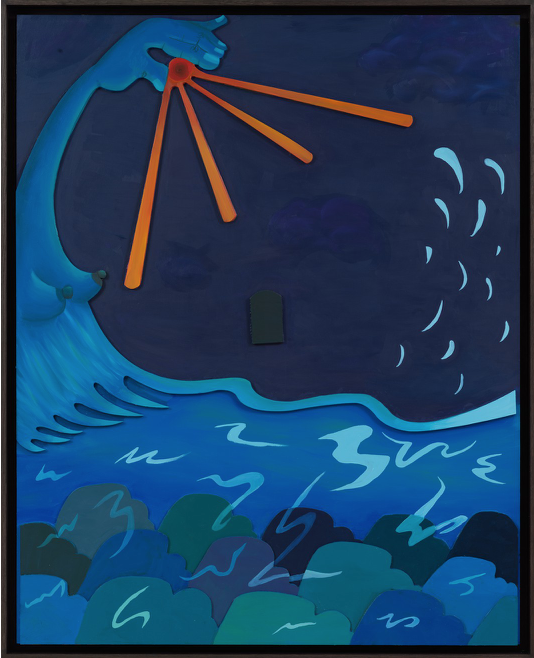
Above: Alexandria Smith, Stars in my pocket, 2022
mixed media on three-dimensional wood assemblage. 62 15/16 x 50 7/8 x 1 3/4 inches 159.9 x 129.2 x 4.5 cm. ©Alexandria Smith. Courtesy Gagosian
In Stars in My Pocket (2022), a three-dimensional mixed media assemblage, a personified wave stretches its long arm-neck above a vast cerulean sea. The hand-head of the Wave-being holds a beaming star. The golden rays of the star shine across the dense waters and illuminate a wide blue-black sky. The ocean that the Wave-being beams across is laden with shadowy silhouettes—stones or heads that line the ocean floor. There is a history in these waters. The Wave-being shines a light on those lost to the waters, brings their abstracted forms into focus. A matte black box that might represent a closed door or window or a yet-to-be-opened portal to the next realm hovers in the distance.
Smith exaggerates the physicality of subjects and space to iterate narratives that transcend and transmute colonial perspectives about interdimensional spacetime, seen and unseen worlds. The magical realist, psychic and psychological realms that Smith illustrates query our relationship to space and time and fortify our capacity to decipher the meta-messages that reside in the boundlessness of our dreams.
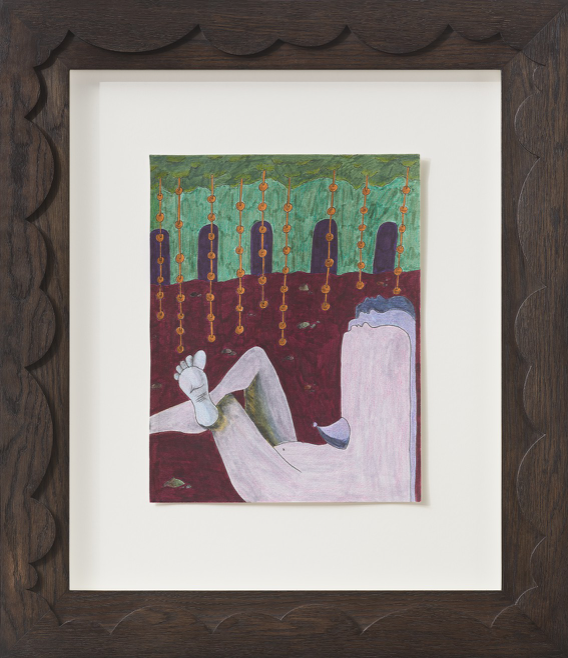
Above: Alexandria Smith, a coloured tomorrowland, 2021
Mixed media on paper in artist frame. 22 1/2 x 19 1/2 x 1 3/4 inches 57.3 x 49.6 x 4.5 cm ©Alexandria Smith. Photo: Prudence Cuming Associates Ltd. Courtesy the artist and Gagosian
In a coloured tomorrowland (2021), a mixed media work on paper, a being sits, head tilted to the sky and legs crossed on a bed of rich soil at the forefront of the frame. The being is split triply; a shadow of a shadow cascades into silhouettes that fade from lavender to deep purple.
There is safe space here. One imagines that the being might be dreaming about a colored tomorrowland, a respite for queer-feminist-womanist bodies to ponder the possibilities of a liberated reality. Five arched doorways extend along the back wall. A row of beaded ropes dangle from the ceiling and settle in the center between the seated being and the doorways. Any pathway to true freedom will be imagined before it can be manifested. The being rests comfortably in this knowing, and by extension, we become hopeful in our individual and collective ability to realize liberation dreams.
“You know, my works and my figures are Black women or Black people, and it’s just the simplest of things, but you know right away that the silhouette is not of a white person … Paring it down to those simple forms also references architecture, [and] it references structure.
A duality, dualism [is] happening. To me, the silhouette and the shadow do something similar. It’s this idea of duplication, representing one thing, but actually taking on its own form because the syllabus paradigm, a shadow is what we do, it’s reflecting on what we do, but it’s doing that in reverse. Duplication [and] repetition are at play for sure. It’s a part of my language.”
Smith has a decolonized imagination and iterates that way of seeing through radically utopic visualizations. The recurring totemic and transformative metaphors she renders act as primary protagonists and significant symbols in her mixed media works. Each assemblage exemplifies Dr. Christina Sharpe’s theoretical assessment of residence time. In spite of the wake, the persistence of unabashed and luminary Black presence across the diaspora shines. By recalling and validating Black existence beyond a trauma-laden lens, Smith recalibrates our collective imagination.
